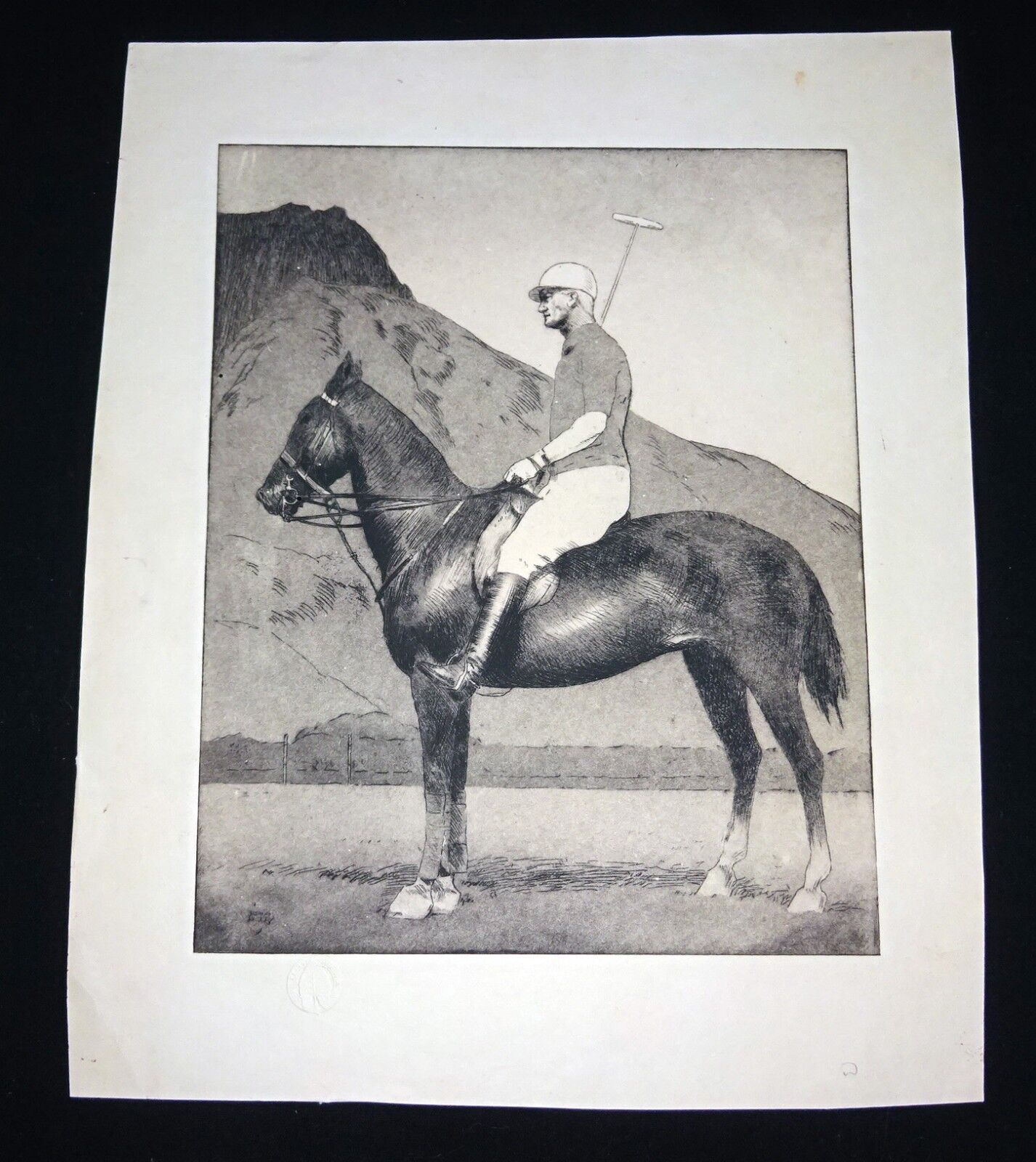Harnisch and Company
1930 Hawaii Etching Print Polo Horse & Rider & Diamond Head by John M Kelly (Kel
1930 Hawaii Etching Print Polo Horse & Rider & Diamond Head by John M Kelly (Kel
Couldn't load pickup availability
Share
We are very excited to have been chosen by the John Melville Kelly estate (Kelly Art Hawaii) to offer some pieces out of their collection to you. Amongst them are obviously piece by the iconic artist John M. Kelly and also pieces by other artists that he accumulated over a lifetime.
Up for sale from the well known Kelly Art Hawaii LLC in Honolulu this 1930s Hawaii black and white etching print depicting Walter F. Dillingham on his polo horse in front of the slope of Diamond head crater and was a commissioned work by iconic artist John Melville Kelly (1879-1962). There are two other pieces from the same series that will be available in this current offering. The condition is described above for more details please check the photos. There will be multiple pieces listed from the collection so please check the others in our eBay store.
Measurements:
Print 10 inches x 7.75 inches
Sheet 13.25 inches x 10.5 inches
More about the artist:
John Melville Kelly was born in Oakland, California in 1879*, and had a long and varied career there until moving to Hawaii, where he achieved fame as an artist.
Kelly worked for many years as an illustrator for the San Francisco Examiner, and had even been a prizefighter, before he and his artist wife, Katherine, went to Hawaii in 1923. Their plan was to stay a year, working for an advertising agency creating material to promote tourism. They fell in love with the islands and the people and stayed permanently.
Kelly's "ravishing depictions of Polynesians" was, in fact, what distinguished him from other artists in Hawaii at the time. He produced etchings and aquatints, primarily of human figures, though he occasionally did landscapes as well. He authored and illustrated Etchings and Drawings of Hawaiians in 1943, and The Hula as Seen in Hawaii in 1955. Kelly died in Honolulu in 1962.
More about the subject:
Dillingham was born in Honolulu, in the Kingdom of Hawaii. His father was Benjamin Dillingham who founded the Oahu Railway and Land Company. His mother was Emma Louise Smith, daughter of missionary Lowell Smith. In 1889 he moved to the United States to attend school in Auburndale, Massachusetts, and then Harvard University 1898-1900. He first worked as a clerk for his father, and then managed the Dowsett Company and founded Hawaiian Dredging Company. In 1904 his father was hospitalized and he managed the OR&L. From 1907-1913, the Governor of the Territory of Hawaii was Walter F. Frear who was married to Dillingham's sister Mary Emma.
In 1909 he constructed a dry dock at Pearl Harbor which eventually became part of the US Navy base. He also enlarged the ports of Kahului and Hilo. On May 2, 1910 he married Louise Olga Gaylord in Florence, Italy. After his father died in 1918, he and his brother Harold Garfield Dillingham inherited the family businesses. During World War I he worked for the US Army Motor Transport Corps in Washington, DC.
Dillingham served on several commissions for the Territory of Hawaii, including the tax appeal court 1908-1910.
In 1919, Dillingham built a large house at Papaʻenaʻena, an ancient Hawaiian altar to the surf and place of human sacrifice to the god Kūkaʻilimoku, on the slopes of Diamond Head. The home, called La Pietra, is now a private academy for girls. It was named after the estate of his wife's relatives where they were married, Villa La Pietra.
Dillingham drained the wetlands of Waikīkī in the early 1920s and created the Ala Wai Canal, on whose banks the Hawaiʻi Convention Center was built. He helped suppress Japanese Hawaiian plantation workers' calls for better labor conditions during the Oahu Sugar Strike of 1920, as chair of the Hawaii Emergency Labor Commission. The Hawaiian Sugar Planters' Association-sponsored commission petitioned the U.S. Senate to lift an 1882 ban on importing workers from China, hoping to use Chinese migrant laborers to replace the Japanese and break the strike. Dillingham is also seen as controversial for comments which by today's standards would be considered racist after the Massie Trial of 1933, which resulted in the killing of a native Hawaiian and the beating of a Japanese Hawaiian by a mob of angry (and never-prosecuted) whites.
In 1948, Dillingham Airfield, a small Air Force base near Mokulēʻia, Hawaii was named for his son Captain Henry Gaylord Dillingham, a B-29 pilot who was killed in action over Kawasaki, Japan on July 25, 1945.
His son Benjamin Franklin Dillingham II (1916-1998) ran with the Hawaii Republican Party against Daniel Inouye for the Senate in 1962 and lieutenant governor in 1974 but lost both elections. The other Senator from Hawaii, Hiram Fong, gave the eulogy at his funeral after his death October 22, 1963. Fong said he lived a life that spanned the full spectrum of Hawaiian history". Dillingham is buried at the Valley of the Temples Memorial Park in Kāneʻohe.
In 1961, his son Lowell Smith Dillingham (1911-1987) merged the remains of the Oahu Railway and Land Company and the Hawaiian Dredging and Construction Company to form the Dillingham Corporation. It was sold to private investors in 1983 for $347 million. A daughter Elizabeth Dillingham (1921-2011) married investment banker Myron Arms Wick Jr. (1915-1990) in 1940
Condition:
The print is in original unrestored condition, it is on heavy paper and evenly toned throughout, has two small bug holes, one in front of the horse face and one on the horse head (see close up photos), the print is signed in the stone but no pencil signature, it also shows the kelly estate stamp, depending on your preference the print can be framed as is or cleaned and backed,


